The Wheelchair Guide
Your Wheelchair and Mobility Scooter Resource
Commercial Wheelchair Lifts
Tuesday, November 9th, 2010
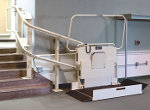 In the home, while building codes and inspections are required, there is generally a much more relaxed attitude towards the use of safety devices, such as wheelchair ramps or porch lifts, but in a commercial environment, there is a much stricter process of ensuring that these sorts of devices not only meet code, but also receive regular maintenance. For this reason, when someone wants to install a commercial wheelchair lift, there are a number of factors that must be considered.
In the home, while building codes and inspections are required, there is generally a much more relaxed attitude towards the use of safety devices, such as wheelchair ramps or porch lifts, but in a commercial environment, there is a much stricter process of ensuring that these sorts of devices not only meet code, but also receive regular maintenance. For this reason, when someone wants to install a commercial wheelchair lift, there are a number of factors that must be considered.
Porch lifts, which is a more colloquial term for vertical platform lifts, are in many ways very similar to an elevator. However, where an elevator requires a great deal of structure, namely the elevator shaft, a vertical platform lift is a single self contained unit. The main advantage of vertical platform lifts over elevators is that they can be placed next to a staircase, providing full access to the area, but with little actual modification to the existing structure of the building.
Meeting and Exceeding City Requirements
When considering installing a commercial wheelchair lift, however, the distinction between elevator and wheelchair lift is often a little less clear, as many cities and municipalities classify these devices as elevators, which must meet similar codes and requirements.
So, the first step for any business owner wishing to install a vertical platform lift, should always be to check city or county codes. A good place to start is to call up your local inspector, which is often located in town hall. If they do not know the codes that a wheelchair lift would fall under, they will be able to point you in the right direction. However, it is important to find and read the required code, with reference books often being available at the library.
A Word About Litigation, the ADA, and Basic Requirements
Making sure the wheelchair lift meets code is important not only for safety and inspection purposes, but also for reducing the risk of a lawsuit or injury. It is important to keep in mind that while in some cases, a vertical platform lift might bring a busi9ness up to code, such as if the business does not meet ADA standards and has no wheelchair ramp, it can also open the business owner up to litigation if there is an injury on the device or a malfunction.
There are several things that a business owner can do to mitigate these risks, such as using a commercially rated wheelchair lift that well exceeds the lifting requirements of the users. In addition to a larger lifting capacity, having a locking mechanism, so the wheelchair lift can only be operated by authorized personal is also very important.
It is also essential that a door is present at the top of the landing, so when the wheelchair lift is moving or at the bottom of the stairs, someone can not fall through the opening. Many commercial wheelchair lifts include a built in door, but it can also be added as an extension of the existing handrail.
A Brief Look At The Three Types of Mobility Scooters
Saturday, June 19th, 2010
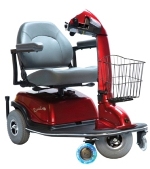 While seniors are not the only group of people to use mobility scooters, they are much more common among the elderly and are a powerful tool for patients who are only partially ambulatory. Mobility scooters are designed to provide supplemental walking assistance to the mobility challenged, safely transporting their rider over both indoor and outdoor terrain.
While seniors are not the only group of people to use mobility scooters, they are much more common among the elderly and are a powerful tool for patients who are only partially ambulatory. Mobility scooters are designed to provide supplemental walking assistance to the mobility challenged, safely transporting their rider over both indoor and outdoor terrain.
Mobility scooters, which are also called electric scooters or adult scooters, have been around for about fifty years, but did not really start to gain popularity until the 1980′s. Since then, names like the Rascal have become household names and many people take advantage of this powerful type of home medical equipment.
There are many brands of mobility scooters and several distinct categories. Understanding how these different types of mobility scooters work and how they are classified can make buying a mobility scooter much easier, as well as helping to narrow down the available choices.
Travel Scooters
Travel Scooters are often the least expensive type of mobility scooter and are designed to be taken apart into several managable pieces. Many include special clips that allow the scooter to be broken down quickly, often with only one hand. When dissasembled, the indivudal pieces of the travel scooter are lightweight and easy to move, with the heaviest piece often weighing less than 30 pounds.
Being able to take the scooter apart makes it much easier to transport, as it can be placed in the trunk of a car, rather than requiring a special scooter lift be installed on the vehicle.
While travel scooters can be a great choice in some cases, they usually lack a lot of the features other mobility scooters have. This is because in order to reduce weight, pretty much anything not related to safety or required for functionality is removed. As a result, travel scooters usually support less weight, have a shorter per-charge range, and are not quite as durable as other mobility scooters.
For everyday use, a travel scooter is often not the best choice, but they can make it much easier and less expensive to transport the device.
Traditional Mobility Scooters
Traditional Mobility Scooters are usually designed to be broken down in a manner similar to that of a travel scooter, but the individual pieces are not quite as lightweight or easy to manage. However, traditional scooter have many other features, both safety related, such as improved suspension, lighting systems, and larger weight capacities, as well as comfort related.
Typically a vehicle scooter lift is required to transport the mobility scooter, which has a significantly higher range than travel scooters.
Heavy Duty Mobility Scooters
Heavy Duty Mobility Scooters, as the name implies, are the Mack Truck of mobility scooters. They are much larger than other types of mobility scooters, making them more difficult to transport, but have a much higher weight rating and are designed to preform well across all types of terrain, including off-road.
They feature larger wheels, a higher ground clearance, reinforced bumpers, and many other features designed to make the device as rugged as possible. Heavy Duty Electric Scooters also have a larger per-charge range and can support a much higher weight capacity than other mobility scooters, as well as having many creature comforts, like a large comfortable captains chair.
Mobility scooters, while excellent for outdoor use, do tend to be pretty large, so they are not always the best choice for tight quarters in a home. Like other types of mobility scooters, most heavy duty mobility scooters can be broken down into several pieces, but it is not uncommon for the lightest piece to be over 100 pounds. So, it is usually not practical to break them down for transportation, at least not for daily transport.
A Basic Guide to Manual and Electric Wheelchairs
Wednesday, May 12th, 2010
 A wheelchair might seem like a rather straightforward device, but there are many parts that go into a modern wheelchair, with some helping to improve the wheelchairs performance, as well as making it easier to use.
A wheelchair might seem like a rather straightforward device, but there are many parts that go into a modern wheelchair, with some helping to improve the wheelchairs performance, as well as making it easier to use.
Traditional Manual Wheelchairs
Today, most manual wheelchairs use a design that is based, at least in part, on the E&J wheelchair, which was developed right before WWII. Not everyone is familiar with the E&J Wheelchair, which is the name of its inventors, Everest and Jennings, but most people have seen them. This is the design that uses hollow metal tubes in the frame and a vinyl seat, which allows the wheelchair to be folded when not in use.
The innovation of this lightweight folding wheelchair made it much easier for those who used wheelchair to be get around when it was first developed, as most other wheelchairs were made of heavy wood and other bulky materials. This not only made it difficult to transport early wheelchairs, but it also made it hard for users to self-propel their wheelchair. The E&J Wheelchair solved these problems and its effect on the modern manual wheelchair can still be seen today.
Sports Wheelchairs
Of course, the sports wheelchair is becoming much more popular, which is a lightweight wheelchair, with performance in mind. There are many different types of wheelchair sports, with many sports having a special wheelchair design. For instance, the wheelchairs used in wheelchair basketball are surrounded by a protective cage and metal bumpers to prevent injuries.
However, there are many much more generic sports wheelchairs around, which are not necessarily designed for a specific sport, but instead include a number of performance features. This includes things like adjustable axles, smaller seats, low profile foot rigging, and many other performance tweaks that make it very maneuverable and fast. Many wheelchair users prefer the sports wheelchair design to that of a traditional folding wheelchair. As an example, most sports wheelchairs have a much lower back, which can make it much easier to turn and reach things behind you.
Electric Wheelchairs
While manual wheelchairs remain very popular, they require a good deal of energy to use, requiring that the person is fit and in good shape. This requires a lot of upper body strength and this is a factor that leads some to use Electric Wheelchairs, although a lot of people simply prefer a power chair to a manual wheelchair.
Power chairs utilize an electric motor and rechargeable battery, being very well suited for indoor use. Most preform well on packed ground as well, but some are more suited for outdoor use than others. Electric wheelchairs are more expensive than manual wheelchairs, but most travel over five miles on a single charge, which is no small task in a manual wheelchair.
There are several types of electric wheelchairs, but two of the most common are the rear-wheel drive wheelchair and the mid-wheel drive wheelchair. A rear wheel drive electric wheelchair provides a slightly stabler base and is a little bit better suited for outdoor use than a mid-wheel drive wheelchair. However, because the drive wheel in a mid-wheel drive wheelchair is located at the center of the device, they are often much more maneuverable.
Folding electric wheelchairs, as well as travel wheelchairs that can be taken apart are also available, which are not as high performance as regular power chairs, but are designed to be transported without a wheelchair lift.
For many, the wheelchair remains one of the most well known and common types of mobility vehicles, providing a service that is different from that of something like a mobility scooter. Wheelchairs have a rich history of innovation and are as common today, as they were 100 years ago.
What Are Manual Wheelchairs and Why Are They So Popular?
Tuesday, April 13th, 2010
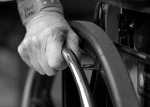 Choosing the best type of wheelchair is something that often comes down to personal preference, although there are certainly a number of other factors involved in this decision, such as physical capabilities and cost. For many, despite the allure of an electric wheelchair, even those heavy duty models that can be driven almost anywhere, a manual wheelchair is still the first choice.
Choosing the best type of wheelchair is something that often comes down to personal preference, although there are certainly a number of other factors involved in this decision, such as physical capabilities and cost. For many, despite the allure of an electric wheelchair, even those heavy duty models that can be driven almost anywhere, a manual wheelchair is still the first choice.
Manual wheelchairs have been used for thousands of years, but the modern design used today is based off of a 1930′s wheelchair called the E&J Wheelchair, developed by Everest and Jennings, two inventors. While there have been many improvements to the manual wheelchair since then, including improved metal working techniques and axle technology, the basic design is quite similar to these early models, which features a hollow metal frame to reduce weight, as well as allowing the wheelchair to be folded when not in use.
A lot of physical effort is required to use a manual wheelchair, which is propelled by the user who pushes on the large rear wheels. A set of hand-rims extends from the wheel, which allows the wheels to be spun easily, without having to touch the part of the wheel that makes contact with the ground. Of course, while many people choose to self propel their manual wheelchair, most also have push handles on the back, so the wheelchair can be pushed from behind.
The front rigging of the wheelchair is the part where the user rests their feet and typically provides two foot rests, although some provide only a single long foot rest, which can be folded up or removed quite easily. A set of parking brakes is also usually attached to the larger rear wheels, which work by simply applying pressure to the wheel and lock in place, holding the wheelchair still.
One of the main improvements to the original E&J Wheelchair has been to the rear axle. The axle connects the two rear wheels, allowing them to spin in unison and makes it possible to move the wheelchair easily in a straight direction, as well as making turning easier. Not only has the axle itself been improved mechanically, but many wheelchairs now offer a movable axle, which allows the user to change the weight distribution of the wheelchair, as well as reducing or increasing resistance.
Of course, cost often also plays a factor, as manual wheelchairs are much less expensive than electric wheelchairs.
A Quick Look At Sports Wheelchairs
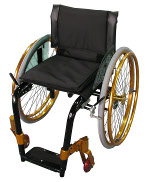 There are many types of manual wheelchairs and one type that has become quite popular in the last 10 or 20 years is the sports wheelchair. Sports wheelchairs come in a variety of designs and styles, including many specialized wheelchairs designed for specific wheelchair sports.
There are many types of manual wheelchairs and one type that has become quite popular in the last 10 or 20 years is the sports wheelchair. Sports wheelchairs come in a variety of designs and styles, including many specialized wheelchairs designed for specific wheelchair sports.
For example, sport wheelchairs designed for wheelchair racing have a very long wheelbase, with the front wheels extending several feet from the rest of the wheelchair, helping to improve stability. Wheelchairs designed for wheelchair basketball, on the other hand, typically have a special metal guard around the chair to protect the user.
Of course, sports wheelchairs do not always have such a glaringly different design and many are simply designed to be as light as possible, while including mechanical upgrades to improve performance. Often, they will feature a more comfortable seat that is made out of a very breathable material, as opposed to the vinyl often used in manual wheelchairs, as well as a lower back or even no back at all. Many find that sports wheelchairs are more practical, even though they don’t play a particular sport.
For instance, for those that work indoors, the lower backrest found on most sports wheelchairs makes it much easier to turn and work around a desk without being inhibited. So, it is common for people to prefer a sports wheelchair over a standard design.
A Look at Manual and Electric Wheelchairs
Tuesday, March 9th, 2010
The wheelchair is probably the most recognized type of mobility vehicle, with its invention being traced back over a thousand years. However, if you were to look at one of the wheelchairs used by people during the 1600′s and compare it to one of those used today, you would be hard pressed to find similarities, aside from both having wheels and their general function.
Manual Wheelchairs
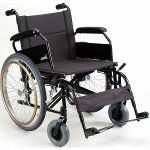 Today, wheelchairs are either manually powered or electric powered. Manual wheelchairs, or self-propelled wheelchairs, remain very popular and are often the least expensive option. Of course, there are exceptions to this rule, but generally a manual wheelchair costs about a third of what an electric wheelchair would.
Today, wheelchairs are either manually powered or electric powered. Manual wheelchairs, or self-propelled wheelchairs, remain very popular and are often the least expensive option. Of course, there are exceptions to this rule, but generally a manual wheelchair costs about a third of what an electric wheelchair would.
The general design of a manual wheelchair is based off of the 1920′s E&J Wheelchair Frame, which was a folding hollow-tubed wheelchair, designed to be easily transported. The basic design has not changed too much and the outline of the E&J wheelchair can still be seen in most modern wheelchair.
Most manual wheelchairs have a a large set of rear wheels, which can be turned by the person sitting in the wheelchair. A metal hand-rim extends from the rear wheel, providing a handhold for the user to grasp and spin the wheel, without having to touch the part that makes contact with the ground. The front wheels are usually much smaller and the front rigging of the wheelchair provides a footrest for the user, so their feet do not touch the ground.
The seat of a standard manual wheelchair is often made out of vinyl, which is looped around the metal tube framing of the wheelchair and sewn in place. However, more breathable fabrics are also available and are more common on sports wheelchairs. When not in use, the wheelchair can be folded up, making it much easier to transport.
While the majority of manual wheelchairs are self propelled, transport wheelchairs are also available, which are designed to be pushed from behind. Transport wheelchairs share a similar design, but the rear wheels are usually smaller and do not have handrims.
Electric Wheelchairs
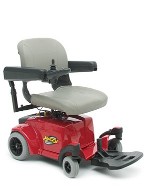 Electric wheelchairs are becoming much more common and offer the same basic functionality of a manual wheelchair, but the chair itself is powered by an electric motor, instead of the wheelchair user. The seat, which varies in size, but often resembles an office chair, is mounted atop a plastic base. The plastic base contains the electric motor and rechargeable battery that powers the wheelchair.
Electric wheelchairs are becoming much more common and offer the same basic functionality of a manual wheelchair, but the chair itself is powered by an electric motor, instead of the wheelchair user. The seat, which varies in size, but often resembles an office chair, is mounted atop a plastic base. The plastic base contains the electric motor and rechargeable battery that powers the wheelchair.
Like a manual wheelchair, electric wheelchairs provide a footrest, but the footrest is usually one piece of plastic, instead of the two individual footrests that are most common on a manual wheelchair. The standard control system for an electric wheelchair is a single joystick control that is mounted to the left or right armrest. The control system allows the wheelchair to be turned and moved by pushing on the joystick, as well as offering buttons to control the speed of the wheelchair. The range can vary depending on the model, as does the speed, but most quality electric wheelchairs can travel around 10 miles per charge and up to 4MPH.
Which is Better? Electric or Manual?
This is something that varies greatly by user and a lot of it comes down to personal preference. However, using a manual wheelchair can be quite strenuous, requiring a good deal of upper body strength, so this is often a factor. Cost also often plays a role, with many quality manual wheelchairs being available for under $500, while most electric wheelchairs cost over $2000.
Another factor to consider is where the wheelchair is going to be used and how often it will be used. A manual wheelchair may end up being easier to transport and better suited for indoor use, while for those who will be traveling across greater distances each day, an electric wheelchair might be a better choice.
Electric Wheelchair Buyers Guide and FAQ
Tuesday, February 2nd, 2010
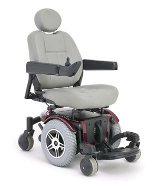 The wheelchair is one of the oldest known mobility aids, greatly improving the lives of those who have difficulty walking. There are many types of wheelchairs available, with sports wheelchairs becoming much more popular over the last ten years. However, for many the choice is whether to buy an electric wheelchair or a manual wheelchair, with both offering their own advantages.
The wheelchair is one of the oldest known mobility aids, greatly improving the lives of those who have difficulty walking. There are many types of wheelchairs available, with sports wheelchairs becoming much more popular over the last ten years. However, for many the choice is whether to buy an electric wheelchair or a manual wheelchair, with both offering their own advantages.
This guide provides the answers to some frequently asked questions about electric wheelchairs, which will help the consumer make an informed purchasing decision.
Electric wheelchairs, which are often called power chairs, are quite popular, but with so many choices and models available, it is important to understand how electric wheelchairs work and what their features are, before submitting to a high pressure sales pitch from your local medical supply store or online dealer.
Table of Contents
- What is an Electric Wheelchair?
- Electric Wheelchairs vs Manual Wheelchairs
- Where Can I Use An Electric Wheelchair?
- What is the Difference Between Mid-Wheel and Rear-Wheel Drive Power Chairs?
- How Are Power Chairs Controlled?
- Are There Any Alternate Control Systems Available for Power Chairs?
- How is the Chair Different Than a Manual Wheelchair?
- What Type of Range and Speed Should I Expect?
- How Do I Transport An Electric Wheelchair?
- What Are Travel Power Chairs?
- What Are Some Popular Power Chair Manufacturers?
What is an Electric Wheelchair?
An electric wheelchair is a motorized wheelchair that is powered using one or more rechargeable batteries. This allows the electric wheelchair, which is often referred to as a power chair, to be used easily away from the home, over both indoor and outdoor terrain.
The first electric wheelchairs, which were developed during the 1950′s, were simply manual wheelchairs that were outfitted with an electric motor, but today, they are custom made.
Electric Wheelchairs vs Manual Wheelchairs
Choosing between a manual wheelchair or an electric wheelchair is often a very personal decision, as they both offer advantages and disadvantages. In many cases, this comes down to personal preference, but there are several important things that should be considered when deciding whether to buy a power chair or a manual wheelchair.
The main advantage of an electric wheelchair is that it requires very little effort to use, while using a manual wheelchair is very strenuous. Where manual wheelchairs require that the user be pushed or self propel, with the latter requiring a great deal of upper-body strength, an electric wheelchair can be controlled with very little effort on the part of the user.
However, one disadvantage of electric wheelchairs is that they are much heavier and more difficult to transport than manual wheelchairs, which will be discussed later in the how do I transport an electric wheelchair section. Another consideration is that manual wheelchairs usually cost significantly less than power chairs.
Where Can I Use An Electric Wheelchair?
Like Mobility Scooters, electric wheelchairs are designed to be used both indoors and outdoors. However, they preform best over tightly packed surfaces. Due to their design, they are also not as well suited for outdoor travel as a mobility scooter is though, usually with a much shorter wheelbase and sometimes smaller wheels, making them work best over concrete or other hard surfaces.
However, unlike mobility scooters, an electric wheelchair can be driven directly up to a table or desk, in the same way that a manual wheelchair can.
What is the Difference Between Mid-Wheel and Rear-Wheel Drive Power Chairs?
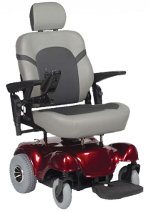 Rear-Wheel Drive Power Chairs typically have four wheels, which are spaced evenly apart from one another. The set of wheels in the back, the rear wheels, are what actually moves the power chair.
Rear-Wheel Drive Power Chairs typically have four wheels, which are spaced evenly apart from one another. The set of wheels in the back, the rear wheels, are what actually moves the power chair.
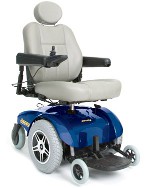 Mid-Wheel Drive Power Chairs, on the other hand, usually have three sets of wheels. The set of wheels in the middle is positioned directly under the seat and the front and back set of wheels are positioned about the same as those on a Rear-Wheel Drive chair. However, it is the middle set of wheels that moves the wheelchair, with the front and back set of wheels providing support and stability.
Mid-Wheel Drive Power Chairs, on the other hand, usually have three sets of wheels. The set of wheels in the middle is positioned directly under the seat and the front and back set of wheels are positioned about the same as those on a Rear-Wheel Drive chair. However, it is the middle set of wheels that moves the wheelchair, with the front and back set of wheels providing support and stability.
The main advantage of a mid-wheel drive wheelchair is that it is more maneuverable than a rear wheel drive wheelchair. Like manual wheelchairs, electric wheelchairs are steered by moving one wheel, while holding the other still. A Mid-Wheel Power Chair allows for a much smaller turning radius, as the turning axis is directly below the wheelchairs seat.
In contrast, a rear-wheel drive wheelchair turns from the back, as this is where the drive wheels are, which means it will have a higher turning radius. However, because the weight of the rider is more evenly distributed between the front and back of the wheelchair, a rear wheel drive wheelchair is typically more stable and better able to support larger weights. To counteract this, some mid-wheel drive wheelchairs are considerably larger and include support wheels that are positioned further from the frame than normal.
How Are Power Chairs Controlled?
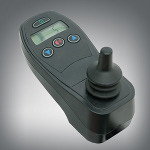 The basic control system that was first developed during the nineteen-fifties is still used today, with a joystick control being the standard control system for most electric wheelchairs. Of course, it is electronically based and made using much better technology, but the concept remains the same.
The basic control system that was first developed during the nineteen-fifties is still used today, with a joystick control being the standard control system for most electric wheelchairs. Of course, it is electronically based and made using much better technology, but the concept remains the same.
Typically, the joystick is mounted to the armrest on either side of the wheelchair, with most models also including simple throttle and horn controls as well.
Are There Any Alternate Control Systems Available for Power Chairs?
For those who are unable to use the traditional joystick control, a number of alternate wheelchair controls have been developed, with many of these having roots in the first wheelchair systems. Power chair control systems that allow the head to control the wheelchair are one of the more common, with several available that allow the wheelchair to be controlled by head movements.
Another popular option allows the users breath to control the movements of the wheelchair, with the user blowing through a small tube, similar to a straw, to move the wheelchair. There are also a number of experimental controls being developed, with one of the most promising allowing the user to control the wheelchair with their tongue, as it is common for movement of the tongue to remain, even in those who are otherwise paralyzed.
There are also a number of control systems developed with the caretaker in mind, which include remote control systems that allow the wheelchair to be controlled by someone walking behind it.
Also in development, there are several systems that allow the wheelchair to learn an environment, either by using GPS to map the environment or by manually adding map. This allows the wheelchair to navigate a room, building, or even campus, using proximity sensors to detect objects in the way. While still currently being developed, there are several live studies of these types of chairs, including one at a nursing home. Other potential controls, which could revolutionize wheelchair movements, include eye tracking software, which is able to detect where a user is looking.
How is the Chair Different Than a Manual Wheelchair?
The seat on most manual wheelchairs is made of vinyl, which is sewn around the frame of the wheelchair, although more breathable materials are also popular, especially on sports wheelchairs. However, the seat of an electric wheelchair more closely resembles a office chair. Some include a high back, with neck rest, while others have a much lower back, but they are typically made in a similar process, with a cushion built atop a hard flat board.
Depending on the model, some power chairs even have a reclining backrest and most allow the seat to be pivoted in both directions, making it easier to transport into and out of the chair.
If you buy a standard power chair, such as those made by Pride Mobility or Golden Technologies, there aren’t really too many options when it comes to the seat. However, special rehab seats are available, which include more supportive headrests, improved cushioning, and fully reclining seats. These power chairs also include individual leg rests that more closely resemble the leg rests used on a manual wheelchair, instead of the single platform that is usually provided for standard power chairs.
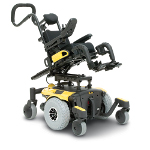 Pride Mobility’s Quantum Rehab division is one of the more well known offers of specialized power chairs, with bariatric and pediatric seats available that are mounted to one of their standard power chair bases. These seats also used a much more ergonomic cushioning that provides improved back support, as well as power tilt, which allows the seat to be reclined electronically.
Pride Mobility’s Quantum Rehab division is one of the more well known offers of specialized power chairs, with bariatric and pediatric seats available that are mounted to one of their standard power chair bases. These seats also used a much more ergonomic cushioning that provides improved back support, as well as power tilt, which allows the seat to be reclined electronically.
Back to Top
What Type of Range and Speed Should I Expect?
This varies depending on the model of scooter, as well as how it is used. However, most travel at speeds of between 3 and 4mph, with a range of around 15 miles.
One thing to keep in mind is that the range and speed is affected by the weight of the rider, as well as the terrain being traveled over. For example, if traveling uphill, the wheelchair’s battery will wear out faster and the chair itself will move slower than when traveling across flat ground.
Also, the battery will need to be replaced periodically, with the wheelchair loosing performance and range as the battery wears down.
How Do I Transport An Electric Wheelchair?
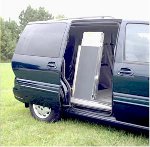 Electric wheelchairs are much heavier than manual wheelchairs and can not be folded up and placed in the trunk the same way you would with a self-propelled wheelchair. While most electric wheelchairs are designed to be taken apart, the individual pieces can be rather heavy and bulky. As a result, those who intend to use the wheelchair away from home, usually need to buy a wheelchair lift or a wheelchair ramp for their vehicle.
Electric wheelchairs are much heavier than manual wheelchairs and can not be folded up and placed in the trunk the same way you would with a self-propelled wheelchair. While most electric wheelchairs are designed to be taken apart, the individual pieces can be rather heavy and bulky. As a result, those who intend to use the wheelchair away from home, usually need to buy a wheelchair lift or a wheelchair ramp for their vehicle.
The least expensive option is the wheelchair ramp, with several foldable metal ramps available. These allow the wheelchair to be driven directly into a van, but do not work as well with other vehicles. Often, these ramps are not actually secured to the van itself, but there are also some van ramps available that are bolted to the floor of the van and can be folded down into place, making it much easier to use independently.
Wheelchair lifts are another option and offer much more flexibility, as they can be used on cars, trucks, SUVs, and Vans. Wheelchair lifts either act as a lifting platform, sort of like an elevator, or as a crane. They are also classified as either internal wheelchair lifts or external wheelchair lifts.
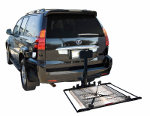 External Wheelchair Lifts are mounted to the hitch of a vehicle and typically store the wheelchair outside on the back end of the vehicle. However, there are several hitch mounted crane lifts that are used to move the wheelchair into inside of the vehicle.
External Wheelchair Lifts are mounted to the hitch of a vehicle and typically store the wheelchair outside on the back end of the vehicle. However, there are several hitch mounted crane lifts that are used to move the wheelchair into inside of the vehicle.
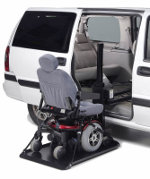 Internal Wheelchair Lifts, on the other hand, store the wheelchair on the inside of the vehicle. These work by either extending a platform from the vehicle onto the ground or by using the crane method. In vans, the platform lift works well when it is installed behind the drivers seat, with the mid row seating of the van removed. However, they can also be used on TRUCKS and SUVS. For passenger cars, a crane lift is usually the only option.
Internal Wheelchair Lifts, on the other hand, store the wheelchair on the inside of the vehicle. These work by either extending a platform from the vehicle onto the ground or by using the crane method. In vans, the platform lift works well when it is installed behind the drivers seat, with the mid row seating of the van removed. However, they can also be used on TRUCKS and SUVS. For passenger cars, a crane lift is usually the only option.
Wheelchair lifts are either powered by a rechargeable battery pack or by directly connecting to the vehicles battery. While wheelchair lifts that are connected to the vehicles battery are sometimes a little more complicated to set up, they end up being much lower maintenance, as you do not need to remember to charge the battery pack. Some wheelchair lifts also allow the wheelchairs charger to be plugged into it, so the wheelchair can be charged while on the road.
What Are Travel Power Chairs?
Travel Power Chairs are electric wheelchairs that are designed to be as lightweight as possible, which can make it easier to travel with them. They are usually designed to be taken apart easily, with the individual pieces being lighter and easier to manage. Also sometimes called portable power chairs, these wheelchairs can sometimes be transported without having to use a wheelchair lift.
However, this comes at the expense of features and range, as the wheelchair is stripped of as much weight as possible. This means a much smaller seat, with less padding, as well as a shorter range and weight capacity.
Folding Power Chairs are also available, which look similar to a manual wheelchair and can be folded in the same way. While these do take up less space than a standard power chair, they are still quite heavy, so are not often the best choice.
What Are Some Popular Power Chair Manufacturers?
Probably the most well known power chair manufactures are Pride Mobility and Golden Technologies, with both companies offering a number of popular and reliable electric wheelchairs. Pride’s Quantum Rehab line is also very popular, as they offer a number of wheelchairs with improved seating and controls, designed with rehab in mind.
While Pride Power Chairs and Golden Power Chairs are the most well known, there are many other manufacturers, with ShopRider Wheelchairs gaining popularity in the past few years by offering a lower price alternative.
When shopping for an electric wheelchair, however, it is important to not only focus on the price of the wheelchair and instead read reviews and consumer reports for each brand, while avoiding the many cheap no-name wheelchairs available. It is also important to make sure the company offers a comprehensive warranty.
The Development of the Modern Wheelchair
Monday, January 25th, 2010
 The wheelchair is one of the oldest types of home medical equipment, dating back thousands of years, with images depicting the use of carts and similar devices, used to transport those with limited mobility. However, if you looked at most of the early wheelchairs, you might not even recognize them as a wheelchair, nor where they something that was generally available to the regular population.
The wheelchair is one of the oldest types of home medical equipment, dating back thousands of years, with images depicting the use of carts and similar devices, used to transport those with limited mobility. However, if you looked at most of the early wheelchairs, you might not even recognize them as a wheelchair, nor where they something that was generally available to the regular population.
In the past, wheelchairs were traditionally only available to those such as nobility or who had the means to have one constructed. This is because there was no set standard to them, so instead the wheelchair had to basically be reinvented each time it was built, relying on the skills of the builder.
Towards the end of the nineteenth century, this began to change, with a semi-standard wicker wheelchair becoming much more common. This was in part due to the increased number of war veterans from the Civil War. These early wheelchairs where relatively inexpensive and featured a large wicker chair, which was often very high backed. Sometimes, however, wood was used in place of wicker, which was much sturdier, but also a great deal heavier.
While a big step up from the older models of wheelchairs, the wicker and wood wheelchairs were very cumbersome and could rarely be transported easily. They also usually required someone to push the wheelchairs, leaving the wheelchair user dependent on friends, nurses, or other caregivers to get around. These wheelchairs would remain common until the early 1930′s, when a much lighter wheelchair was developed.
The improved wheelchair, which was developed during the 1930′s was referred to as the E&J wheelchair, named for its inventors Everest and Jennings. What sets this apart from other wheelchairs was that it had a solid metal frame, constructed using hollow steel tubes. This provided a great deal of strength, but because the metal was hollow, it was not very heavy. The E&J wheelchair could also be folded up, making it much easier to transport in carriages and the less common automobile. In addition, the wheelchair featured large front wheels, allowing the wheelchair user to self propel, without the need to rely on a caretaker.
As was the case with the previous wheelchair design, much of the innovation and adoption was the result of injured veterans, this time from World War I. A few years later, World War II would begin and the E&J wheelchair would become the default wheelchair design.
By the 1950′s, the E&J wheelchair was still the most common choice of wheelchair, with inventors creating a electric wheelchair kit that could be used to convert a regular manual wheelchair to an electric one. These kits became very popular, with companies from Canada and New York developing quick converter kits.
Today, the E&J wheelchair design is still seen in most manual wheelchairs, with its lightweight hollow metal frame and folding design, making it a great choice for traveling. In fact, Everest and Jenning wheelchairs are still available, as the company has remained a powerful name in the wheelchair industry.
Manual Wheelchairs vs Electric Wheelchairs: A Buyers Guide
Monday, January 4th, 2010
Wheelchairs are important safety tools that are used by those who are unable to walk or have difficulty doing so. While the wheelchair has roots that date back thousands of years, modern wheelchairs are based off of a hollow steel tube design that was developed during the 1930′s. This design remains popular today and helps keep the weight of the wheelchair down, without sacrificing its strength.
While the folding steel tube manual wheelchair is still very common, many wheelchair users prefer electric wheelchairs. Electric wheelchairs offer the same basic functionality that manual wheelchairs offer, except they are operated electronically. Electric wheelchairs also have a design that is much different than a manual wheelchair is.
How Manual Wheelchairs are Designed
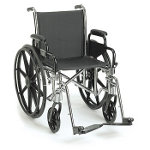 A manual wheelchair usually has a wide chair, with two large wheels on either side and two small wheels in front. The larger wheels have handrails that extend off of the wheel and allow the user to move the wheels, without having to actually touch that part f the wheel that makes contact with the ground.
A manual wheelchair usually has a wide chair, with two large wheels on either side and two small wheels in front. The larger wheels have handrails that extend off of the wheel and allow the user to move the wheels, without having to actually touch that part f the wheel that makes contact with the ground.
Many manual wheelchairs also have push handles that extend backwards from the top of the chairs seat, allowing someone to push the wheelchair from behind.
While most manual wheelchairs are designed to be self-propelled, which is why they have the larger rear wheels, some wheelchairs are only designed to be pushed. These wheelchairs, which are sometimes called transfer wheelchairs or transport wheelchairs, have much smaller wheels.
Sports wheelchairs are also very popular and come in a variety of designs. Some, like those used during wheelchair basketball or wheelchair rugby, are very specialized. For example, since wheelchair basketball can be so dangerous, a wheelchair basketball sports wheelchair will have a guard around the entire wheelchair. Another example of a specialized sports wheelchair is those used for wheelchair racing, which have a much longer wheelbase than other wheelchairs.
Other sports wheelchairs offer a much less specialized design, with a focus more on being lightweight and small, while allowing for optimal turning and speed. These are a popular choice by many wheelchair users, even those who do not actually play wheelchair sports.
How Electric Wheelchairs Are Designed?
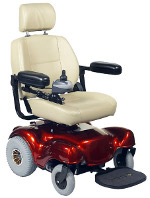 Electric Wheelchairs, on the other hand, are not intended to be self-propelled and are instead operated using a rechargeable battery. As a result, they only have a limited range before the battery must be recharged.
Electric Wheelchairs, on the other hand, are not intended to be self-propelled and are instead operated using a rechargeable battery. As a result, they only have a limited range before the battery must be recharged.
The weight of the rider as well as what type of terrain is driven over can affect the wheelchairs per-charge range. So, for example, driving up hill will wear the battery out quicker than driving it on level ground. With that said, many have ranges that are over 8 miles per charge, which is a fairly large distance for most people.
Unlike manual wheelchairs, the wheelbase of an electric wheelchair is very small. Some have four small wheels, with the rear wheels being responsible for actually moving the wheelchair. Other power chairs use a mid-wheel drive system, with a set of wheels in the front and back that provide support, while the set of wheels in the middle are responsible for moving the chair. Usually a mid-wheel drive power chair is much more maneuverable than a rear-wheel drive power chair.
Atop of the plastic base of the power chair, a captains chair is installed. Usually the captains chair is designed similarly to an office chair. The armrests can be folded up and the actual control system is placed on either the right or left armrest. The chair can also be pivoted to make it easier to enter and exit the wheelchair.
Like office chairs, the style of the captains chair varies depending on the model of the electric wheelchair. For instance, some will have a much higher back with head and neck support, while others have a considerably lower back without any neck support.
What is Best For Me?
Often, choosing between a power chair or a manual wheelchair comes down to personal preference. For instance, many prefer the physical effort that is required to use a manual wheelchair, while others find that it is too strenuous.
Cost is also a factor, as you can usually find a quality manual wheelchair for less than $500, while an electric wheelchair usually starts at $1500 and goes up from there.
It is also important to consider where you will be using the wheelchair, as if you are only planning on using it around the home, an electric wheelchair could be overkill. On the other hand, someone going to school and traveling across campus daily might prefer an electric wheelchair.
Transporting the wheelchair is another concern. Most manual wheelchairs are designed to be folded when not in use. This allows them to be stored in the trunk of a car or even the backseat with little difficulty. Electric wheelchairs, on the other hand, are considerably heavier and will often require some sort of wheelchair lift is installed onto the automobile.
Another consideration is that a Manual Wheelchair will almost always work, providing it is regularly maintenance. An electric wheelchair is more prone to mechanical or electrical failure, as well as being more sensitive to rain and other elements. As a result, a manual wheelchair often provides a much more long term and dependable option, without the need for replacing batteries or other maintenance that is required on a power chair.
A Closer Look at the Mobility Scooter
Saturday, December 26th, 2009
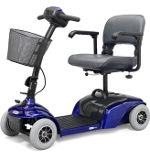 Mobility scooters are not exactly new devices and have been around for some time, with the first models first being developed around forty years ago. Up until the nineteen-eighties the cost of mobility scooters, and for that matter electric wheelchairs, was often rather prohibitive, making the device not as common. However, due to increased competition and improved manufacturing techniques, mobility scooters are relatively inexpensive today and are extremely popular among the elderly.
Mobility scooters are not exactly new devices and have been around for some time, with the first models first being developed around forty years ago. Up until the nineteen-eighties the cost of mobility scooters, and for that matter electric wheelchairs, was often rather prohibitive, making the device not as common. However, due to increased competition and improved manufacturing techniques, mobility scooters are relatively inexpensive today and are extremely popular among the elderly.
A mobility scooter is a motorized device that is used to carry a single person around their home or as they complete daily activities. Using rechargeable batteries, many mobility scooters are able to support an individual weighing more than 300 pounds over distances exceeding 10 miles on a single charge.
Differences Between Electric Wheelchairs and Mobility Scooters
The function and manufacture of mobility scooters is actually quite similar to that of an electric wheelchair, but the actual design of these two devices is usually quite different.
Since an electric wheelchair is intended for constant use by its owner, it is designed so that it can be driven directly up to a table or desk, with its captain’s chair being positioned atop a small plastic base.
Mobility scooters, on the other hand, are designed more as a walking supplement and are usually used by those who are able to walk on their own for short periods of time. So, a much longer plastic base is used, with a set of handlebars extending from the front of the base.
The handlebars, or tiller as it is usually referred to, make it impossible for a mobility scooter to be driven directly up to a table or desk in the same manner as a wheelchair could be. They also usually contain headlights, turn signals, and other gauges to indicate things like battery strength.
Due to the larger wheelbase of a mobility scooter in relation to an electric wheelchair, they are often better suited for uneven terrain and outdoor conditions.
Types of Mobility Scooters
There are actually quite a few different types of mobility scooters. There are a number of ways to classify them, such as by their range and weight capacity, as well as their intended use.
One of the most common ways to differentiate between different types of mobility scooters is by classifying them as travel scooters, heavy duty scooters, and traditional scooters.
Travel Scooters are designed so that the scooter can be easily disassembled into more manageable pieces. As the name implies, this can make it much easier to travel with, as there is no need for a vehicle scooter lift and often the heaviest piece weighs around thirty pounds, so most people can lift the scooter into their trunk without difficulty. Of course, travel scooters have fewer features and are less durable, as they are instead designed to save weight.
Heavy Duty Scooters are designed for rugged outdoor use and to support a great deal more weight, often well over 500 pounds. They also have a much higher top speed and range than other scooters, as well as being better suited for outdoor conditions. This includes reinforced bumpers, larger wheels, more comfortable seats, and a wider wheelbase. However, due to their size, transporting a heavy duty scooter usually requires a scooter carrier and they may not work as well in the tight corners of a home.
Traditional Scooters fall in between travel scooters and heavy duty scooters. They usually include more features and can often be disassembled, but the individual pieces are heavier than a travel scooter. They also usually have a larger per-charge range and weight capacity than a travel scooter would, while being less than that of a heavy duty scooter.
The Importance of the number of Wheels
The number of wheels an adult scooter has is also used to classify the scooter and can determine what type of activities it is best suited for.
For outdoor use, a four wheel scooter is usually the best choice, as it is more stable and able to provide better weight support. Most heavy duty scooters are four wheeled, as this provides better stability.
A three wheel scooter will typically be more maneuverable, as it has a smaller wheel base, making it a good choice for indoor use. Many travel scooters will use a three wheel design as this makes it lighter as well. In general, an electric scooter with three wheels has a much smaller turning radius, which also causes it to be less stable.
Increasing Wheelchair Accessibility: The Front Steps
Monday, November 23rd, 2009
For wheelchair users, making sure that all areas of a home is accessible is very important, not just to make getting around easy, but also to address safety concerns. In most cases, ensuring a home is wheelchair friendly starts with the front entrance.
Depending on how a home is set up, the front or side door usually presents the first and sometimes only hurdle to a wheelchair user. So, finding a way to safely and cost effectively bridge this gap is very important and largely depends on the type of door in the home.
Most homes have at least one or two steps separating around most entrances, which can present a very big obstacle to those who use wheelchairs.
Small Wheelchair Ramps
If there are only a few steps, installing a small ramp is sometimes the quickest, easiest, and least expensive way of ensuring wheelchair access.
Ramps come in a variety of sizes and designs, both made out of wood and metal. Since the length of a wheelchair ramp is directly proportional to the length of the staircase, the lower the staircase, the shorter the ramp.
If the staircase is only a few feet high, it is usually possible to install a very short ramp, which can be removed or repositioned as necessary. Often, folding metal ramps are used, which are also popular for use with larger vans. If the ramp does not fold, then it is usually made as a single piece, much like a large board of plywood, but much stronger and more rigid.
One of the main advantages of using a short semi-permanent ramp is cost, as these tend to be the least expensive to build or purchase. They can also be quickly removed as needed and typically don’t take up all that much space. However, these types of ramps only work on very short stairways.
For larger staircases, a much longer ramp is needed. Depending on space, this sometimes means creating a zig-zag design, rather than a straight ramp. Usually, as a result of how much longer of a ramp you would need for a larger staircase, installing the ramp on the front of the house is a necessity.
Large Wheelchair Ramps
Like the smaller ramps, it is possible to go with a metal or wooden design. The wooden design is popular, as the materials to build a wheelchair ramp are not very expensive, so if you know someone who is handy, building your own wheelchair ramp is often the best choice from a monetary standpoint. Metal wheelchair ramps are also available and come in sections, making it a modular wheelchair ramp. The number of sections varies by the height of the steps and installing the ramp is simply a matter of connecting the individual sections.
Wheelchair ramps are popular as they do not require any electricity to use and usually don’t have any moving parts, so there are few points that could fail. In most cases, providing the proper type of wood is used and faulty boards are replaced as needed, a wooden wheelchair ramp will last as long as needed.
However, wheelchair ramps do require that the user is able to move themselves along the ramp and depending on the height of the staircase, they can take up a great deal of yard space.
Wheelchair Lifts
Wheelchair lifts or, as they are typically referred to in the industry, vertical platform lifts, represent one of the easiest and safest ways of increasing staircase accessibility. For all intensive purposes, a vertical platform lift is simply a self-contained elevator. Unlike the type of elevators you would see inside of a building, wheelchair lifts do not require a large shaft in the home or much modification to the home. Instead, wheelchair lifts need only be placed next to the staircase landing on a strong surface made out of wood or concrete.
To use a wheelchair lift, the user simply drives their wheelchair onto its platform and activates the call buttons. The platform than lowers or rises the distance of the staircase. One of the advantages of a wheelchair lift is that it can be used easily and requires very little effort on the part of the wheelchair user or caretaker. Simply pushing a button is all it takes to make the stairs safer. Wheelchair lifts also do not take up much front yard space.
However, wheelchair lifts represent the most expensive option, costing significantly more than building your own wheelchair ramp.